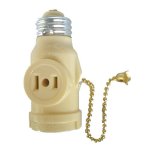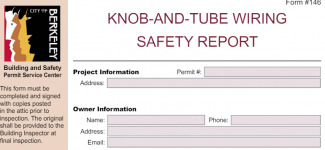Fred B
Senior Member
- Location
- Upstate, NY
- Occupation
- Electrician
I have yet to see ANY K&T that hasn't been "disturbed", altered, modified, or just plainly slaughtered over the years. Only positive I can say regarding K&T is I never seen rodents chewed K&T wire, even with significant evendence of their presence (nut shells in ceiling attic space).
Currently working on a "modified" system that I have been replacing that has multiple points of modifying that created mutliple reversal of L/N down the line and even someone "making" a fused neutral in the original fuse box used as a "sub panel" from the "newer" service with breaker panel. Also Live K&T Just cut off and left dangling with no wirenut covering at the bare end buried in attic insulation. Light fixtures with no neutrals, or a switched neutrals. Open up receptical or light fixture and it looks like I've got rag wire but it was fed by K&T with a flying splice. Broked Tubes or knobs throughout as well.
Alot of the time will have situation by just shuting down the K&T circuit that it will "kill" half the house, "hit and miss" throughout the house depending on what was modified and when. A what I call "here is a wire let's use that" syndrome.
Had investigated one K&T system sooo bad that I could stand in middle of living room and my ticker would ring off as if I was tracing on a live wire.
So would I EVER tell a customer that it's OK to leave the K&T active? NOOO.
Currently working on a "modified" system that I have been replacing that has multiple points of modifying that created mutliple reversal of L/N down the line and even someone "making" a fused neutral in the original fuse box used as a "sub panel" from the "newer" service with breaker panel. Also Live K&T Just cut off and left dangling with no wirenut covering at the bare end buried in attic insulation. Light fixtures with no neutrals, or a switched neutrals. Open up receptical or light fixture and it looks like I've got rag wire but it was fed by K&T with a flying splice. Broked Tubes or knobs throughout as well.
Alot of the time will have situation by just shuting down the K&T circuit that it will "kill" half the house, "hit and miss" throughout the house depending on what was modified and when. A what I call "here is a wire let's use that" syndrome.
Had investigated one K&T system sooo bad that I could stand in middle of living room and my ticker would ring off as if I was tracing on a live wire.
So would I EVER tell a customer that it's OK to leave the K&T active? NOOO.





